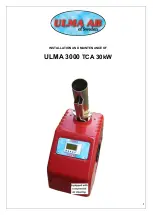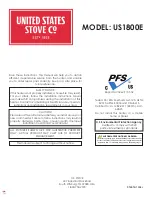
ATENA - DUKE - SABA - MITHOS
9
LEGENDA
WHERE TO DISPOSE
MATERIALS
A. OUTER CLADDING
If there is any, to be disposed of separately based on
the material used:
Metal
Glass
Tiles or ceramics
Stone
B. GLASS DOORS
If there is any, to be disposed of separately based on
the material used:
Glass ceramic (fire door): to be disposed of with
inert or mixed waste
Tempered glass (oven door): to be disposed of with
glass
C. INTERIOR CLADDING
If there is any, to be disposed of separately based on
the material used:
Metal
Refractory materials
Insulating panels
Vermiculite
Insulation, vermiculite and refractory materials
that have come into contact with flames or exhaust
gases (dispose of in mixed waste)
D. ELECTRIC AND ELECTRO-
NIC COMPONENTS
To be disposed of separately in authorised centres,
as indicated in the WEEE directive 2012/19/EU and
the relative national transposition.
Wiring, motors, fans, circulators, display panels,
sensors ignition plug, electronic cards, batteries.
E. METAL STRUCTURE
To be disposed of separately with metal -
F. COMPONENTS THAT CAN-
NOT BE RECYCLED
To be disposed of with mixed waste
E.G.: Gaskets, rube piping, silicone or fibres, plastic.
G. HYDRAULIC COMPONENTS
Piping, fittings, expansion vessel, valves. If there
are any, to be disposed of separately based on the
material they are made of:
Copper
Brass
Stainless steel
Other materials
6.2
INFORMATION FOR MANAGEMENT OF ELECTRIC AND ELECTRONIC APPLIANCE WASTE CON-
TAINING BATTERIES OR ACCUMULATORS
Fig. 2 - Waste disposal
This symbol, which is used on the product, batteries, accumulators or on the packaging or documents, means that at the end of its
useful life, this product, the batteries and the accumulators included must not be collected, recycled or disposed of together with
domestic waste.
Improper management of electric or electronic waste or batteries or accumulators can lead to the leakage of hazardous substances
contained in the product. For the purpose of preventing damage to health or the environment, users are kindly asked to separate
this equipment and/or batteries or accumulators included from other types of waste and to arrange for disposal by the municipal
waste service It is possible to ask your local dealer to collect the waste electric or electronic appliance under the conditions and
following the methods provided by national laws transposing the Directive 2012/19/EU.
Separate waste collection and recycling of unused electric and electronic equipment, batteries and accumulators helps to save
natural resources and to guarantee that this waste is processed in a manner that is safe for health and the environment.
For more information about how to collect electric and electronic equipment and appliances, batteries and accumulators, please
contact your local Council or Public Authority competent to issue the relevant permits.
6.3
INSTRUCTIONS FOR PACKAGING DISPOSAL
The material that the appliance’s packaging is made of must be managed correctly, in order to make collection, reuse, recovery
and recycling easier, where possible.
The table below illustrates the possible components that the packaging is made of, and the relative instructions for correct disposal.










































